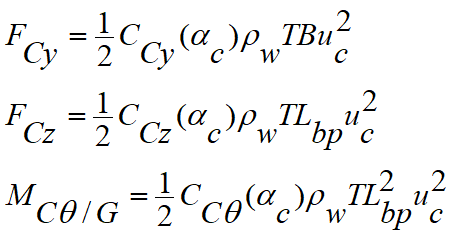Vessel wind loads are calculated using:
 (1)
(1)
where:
•![]() ,
, ![]() and
and ![]() are the wind coefficients in surge, sway and yaw respectively for an equivalent wind incidence of
are the wind coefficients in surge, sway and yaw respectively for an equivalent wind incidence of ![]()
•![]() is the air density
is the air density
•![]() is the transverse area of the vessel which is exposed to wind action
is the transverse area of the vessel which is exposed to wind action
•![]() is the longitudinal area of the vessel which is exposed to wind action
is the longitudinal area of the vessel which is exposed to wind action
•![]() is the equivalent wind velocity
is the equivalent wind velocity
The equivalent wind incidence ![]() is obtained using:
is obtained using:
 (2)
(2)
where:
•![]() is the (global) wind velocity
is the (global) wind velocity
•![]() is the wind direction as defined in the Wind and Current Directions figure.
is the wind direction as defined in the Wind and Current Directions figure.
The equivalent wind velocity ![]() is given by:
is given by:
![]() (3)
(3)
•*MOORED VESSEL is used to define a moored vessel and its associated properties. Specifically, the TYPE=GEOM inputs are used to specify vessel geometrical data such as draft, beam, length between perpendiculars etc.
•*WIND is used to specify wind loading.
•*WIND COEFF is used to specify wind coefficients used to determine the wind loading on a floating body or moored vessel.
If you would like to see an example of how these keywords are used in practice, refer to D01 - Moored Vessel